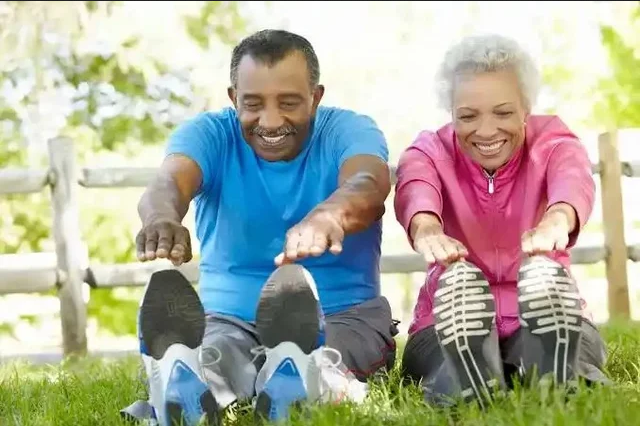
As we age, it becomes increasingly important to maintain our physical health and fitness. Regular exercise offers a range of benefits, including improved cardiovascular endurance, increased strength and flexibility, and reduced risk of developing chronic diseases….CONTINUE READING
However, not all exercises are suitable for older individuals, as the body may require specific movements and modifications. Therefore, let’s delve into a comprehensive list of exercises that older people should do more often, taking into account their safety and unique requirements.
1. Walking:
According to webmd, A simple yet effective exercise that suits individuals of all ages, walking provides numerous health benefits. It improves cardiovascular health, strengthens leg muscles, and enhances balance. Older adults can start with shorter walks and gradually increase duration and intensity. Consider incorporating walking into your daily routine by taking a stroll around the neighborhood or walking to nearby places instead of driving.
2. Strength Training:
Building muscle strength is vital for older individuals as it helps maintain independence in daily activities and reduces the risk of falls. Strength training exercises can include using hand weights, resistance bands, or weight machines. Focus on major muscle groups, such as the legs, arms, chest, and back. Aim for two to three sessions per week, allowing a day of rest in between.
3. Tai Chi:
This ancient Chinese practice combines slow, flowing movements with deep breathing and relaxation. Tai Chi is excellent for balance, mobility, and reducing the risk of falls. Moreover, it provides mental benefits by promoting mindfulness and stress reduction. Joining a Tai Chi class specifically designed for older people can help ensure proper technique and safety.
4. Water Aerobics:
Exercising in water is gentler on the joints, making it an ideal option for seniors with arthritis or joint pain. Water aerobics can include various movements such as marching, jumping jacks, and kicking. This low-impact exercise enhances cardiovascular fitness, builds muscle strength, and improves flexibility. Look for local community pools or wellness centers that offer water aerobics classes.
5. Yoga:
Yoga is a versatile exercise for people of all ages, providing physical and mental benefits. It improves flexibility, strength, and balance while promoting relaxation and stress relief. However, older individuals should opt for gentle or chair yoga classes, which focus on modified poses and take into account any physical limitations. Always inform the instructor about any health concerns or medical conditions before starting yoga.
6. Stretching:
Stretching exercises are essential for maintaining flexibility, preventing muscle imbalances, and reducing the risk of injury. Include both static stretches, where you hold a position, and dynamic stretches, where you move fluidly through a range of motion. Stretch major muscle groups, such as the legs, arms, and back, and perform stretches after a proper warm-up or after exercise.
7. Cycling:
Cycling is a low-impact aerobic activity that is kind to the joints, making it an excellent exercise option for older individuals. It improves cardiovascular fitness, leg strength, and joint mobility. Whether opting for outdoor cycling or using a stationary bike, start with shorter distances and gradually increase duration and intensity. Always wear a helmet and follow local cycling safety guidelines.
8. Pilates:
Pilates focuses on core strength, flexibility, and postural alignment. It helps improve balance and stability, alleviating back pain or discomfort. Modified versions of Pilates exercises can be done using a mat, exercise ball, or resistance bands. Consider joining a Pilates class for older adults or consulting a certified instructor to learn suitable modifications.
9. Balance Exercises:
Balance exercises are crucial for older individuals as they can prevent falls and maintain independence. Stand on one foot while holding onto a stable support if needed, then gradually increase the duration. Alternatively, take part in activities such as yoga, Tai Chi, or dance classes, which often incorporate balance exercises. Always prioritize safety by performing these exercises near a sturdy support or with someone nearby to assist if necessary.
10. Flexibility Exercises:
Maintaining flexibility is essential for older adults to perform daily activities with ease and to prevent muscle stiffness or tightness. Gentle stretching exercises, such as neck rotations, shoulder rolls, and hamstring stretches, should be performed regularly to maintain joint mobility and prevent muscle imbalances. Incorporate these exercises into your daily routine, or consider attending a stretching class designed specifically for older individuals.
It is essential to consult with a healthcare professional before starting any new exercise regimen, especially if you have any pre-existing medical conditions or concerns. Additionally, listen to your body and modify any exercises that cause discomfort or pain. Stay consistent with your exercise routine, gradually increasing intensity and duration to promote ongoing fitness and wellness.
Regular exercise offers immense benefits for older individuals. Walking, strength training, Tai Chi, water aerobics, yoga, stretching, cycling, Pilates, balance exercises, and flexibility exercises are all excellent options to include in your fitness routine. Remember to prioritize safety and adapt exercises to your physical capabilities. By incorporating these exercises into your daily life, you can improve your overall health, fitness, and quality of life….CONTINUE READING